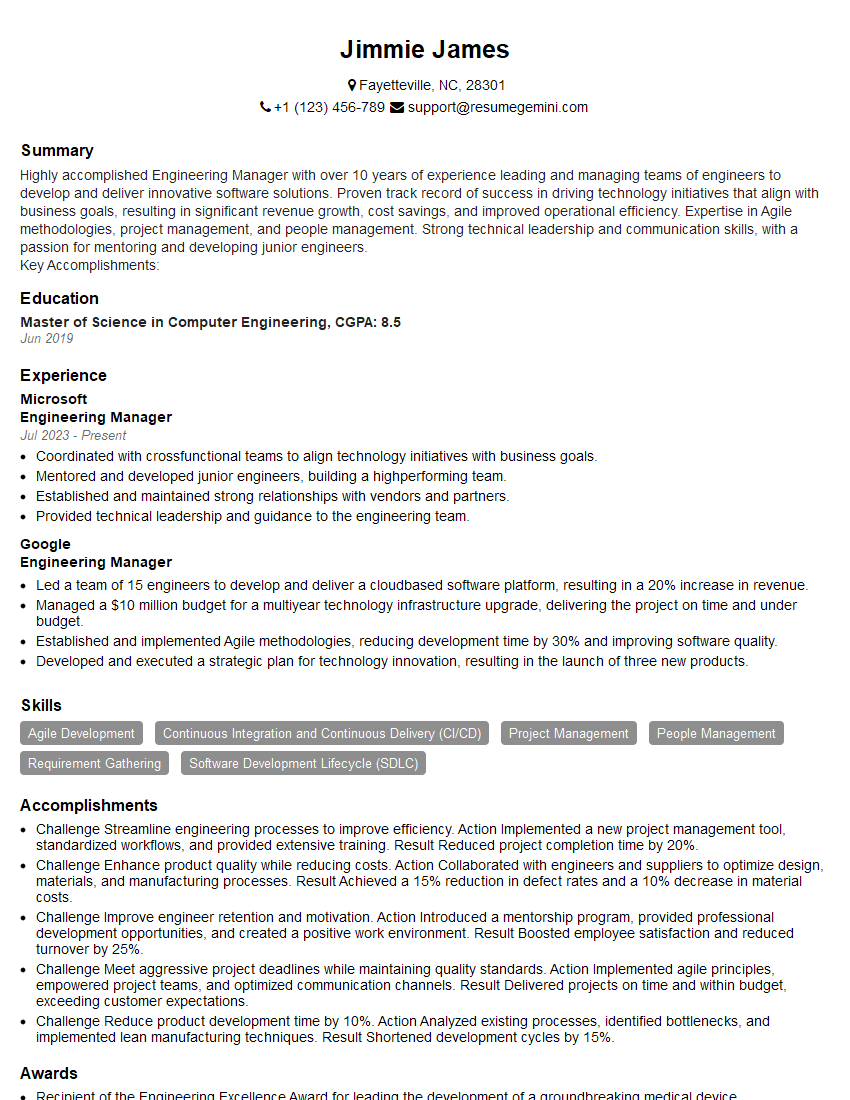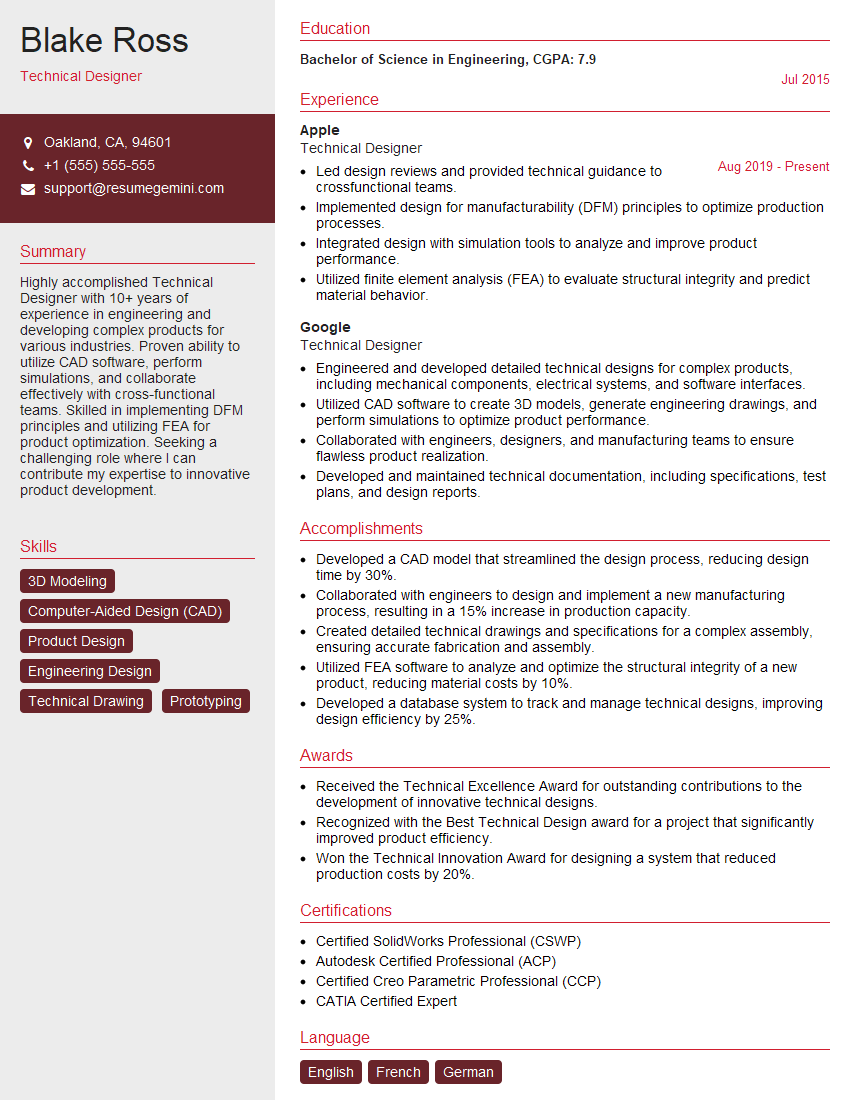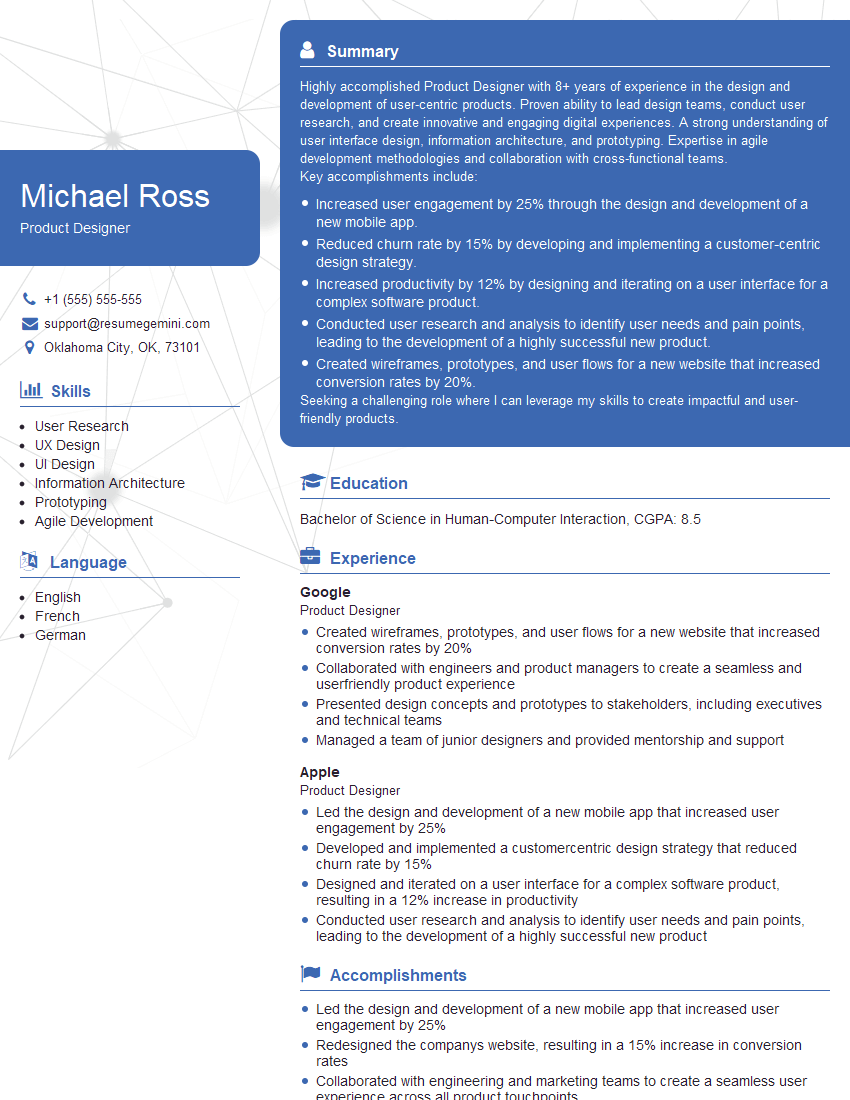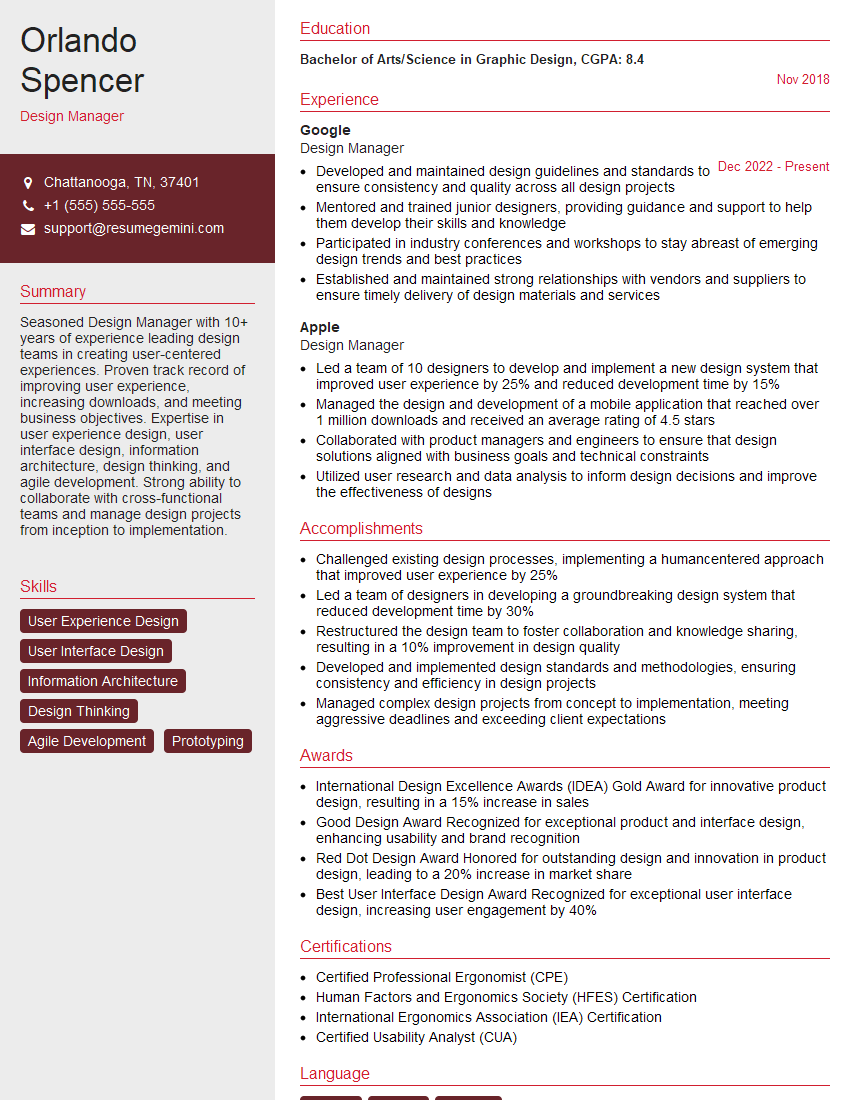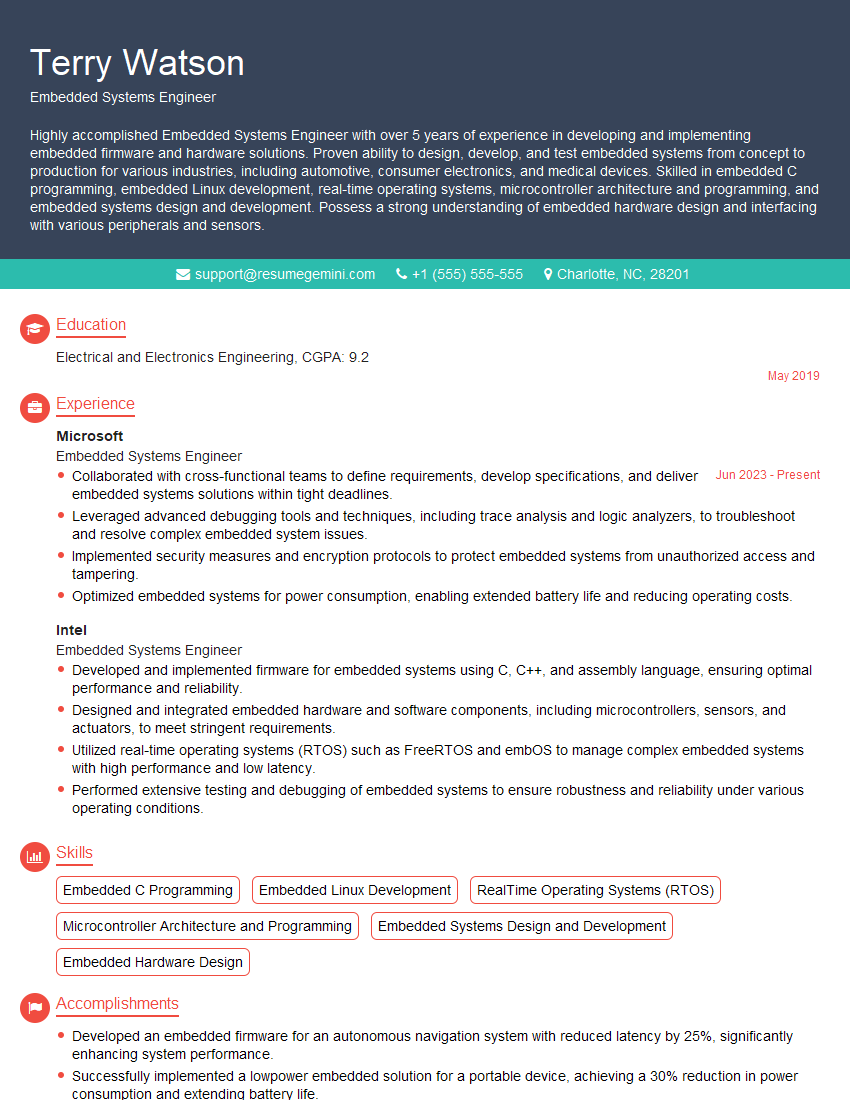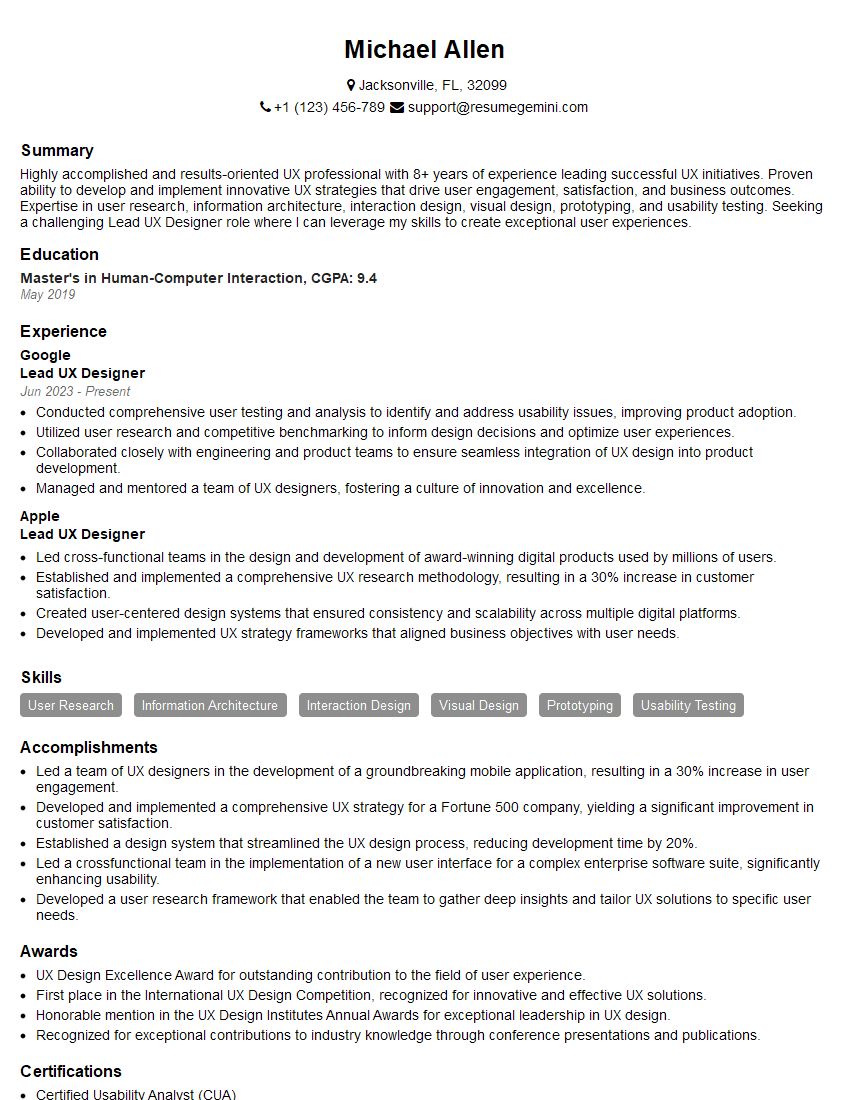The right preparation can turn an interview into an opportunity to showcase your expertise. This guide to Interfacing with Design Teams and Engineers interview questions is your ultimate resource, providing key insights and tips to help you ace your responses and stand out as a top candidate.
Questions Asked in Interfacing with Design Teams and Engineers Interview
Q 1. Describe your experience facilitating communication between design and engineering teams.
Facilitating communication between design and engineering teams is crucial for successful product development. It’s about creating a bridge between creative vision and technical feasibility. My approach involves establishing clear communication channels, regular meetings, and a shared understanding of project goals. I believe in proactive communication – anticipating potential roadblocks and addressing them before they escalate into major conflicts.
For instance, in a previous project involving a mobile application, I implemented weekly cross-functional meetings. Designers presented mockups and prototypes, while engineers discussed technical constraints and potential solutions. This ensured everyone was on the same page regarding design direction and technical feasibility. We also used a shared online project management tool to track progress, share files, and document decisions transparently. This facilitated asynchronous communication and ensured everyone had access to the latest information.
Furthermore, I encourage active listening and empathy. Designers need to understand the limitations of engineering, while engineers need to appreciate the design vision. Building trust and fostering a collaborative environment are key to bridging the communication gap.
Q 2. How do you handle conflicting priorities between design and engineering requirements?
Conflicting priorities between design and engineering are inevitable. My approach centers around collaborative problem-solving and prioritization. I facilitate discussions where both teams clearly articulate their requirements and constraints. We then work together to find a balance that respects both design aesthetics and technical limitations.
A framework I often employ involves using a prioritization matrix. We list all requirements and then rate them based on impact and feasibility. This helps visualize trade-offs and make data-driven decisions. For example, if a high-impact design element proves technically challenging, we might explore alternative design solutions that achieve a similar outcome but with less technical complexity. Sometimes, compromises involve phasing in features – initially launching with a simpler implementation and iteratively enhancing the design based on user feedback and technical capabilities.
Open communication and transparency are paramount. Avoiding blaming and focusing on finding mutually agreeable solutions are essential for maintaining a positive team dynamic and fostering collaboration.
Q 3. Explain your process for translating design specifications into technical requirements.
Translating design specifications into technical requirements is a systematic process. It involves a detailed analysis of design documents, wireframes, mockups, and prototypes. I work closely with designers to understand the design intent behind each element. This step is crucial to prevent misinterpretations.
My process involves creating a detailed requirements document that maps design elements to technical specifications. This document clearly defines functionality, user interactions, performance criteria, and technical constraints. For example, if a design specifies a specific animation effect, the technical requirements will specify the animation type, duration, and any technical limitations. This document becomes the shared understanding between the design and engineering teams and guides the development process.
The use of established standards and naming conventions is crucial. For example, using a consistent naming system for design elements and components simplifies communication and ensures everyone understands what’s being discussed. Regular reviews of this document ensure accuracy and prevent discrepancies between the design vision and the technical implementation.
Q 4. How do you ensure design and engineering teams maintain a shared understanding of project goals?
Maintaining a shared understanding of project goals requires consistent communication and a shared vision. I achieve this by initiating kickoff meetings where both teams collaboratively define project objectives, key performance indicators (KPIs), and success metrics. This ensures everyone understands what we are building and why.
Visual aids, such as user stories and journey maps, are incredibly helpful. These illustrate the user experience and help engineers connect their work to the overall user goals. Regular progress updates, demonstrations, and feedback sessions help maintain alignment throughout the development process. Open communication channels, such as a shared project management tool or collaborative design platform, further enhance team cohesion and ensure everyone is informed of any changes or challenges.
I also encourage the use of collaborative design tools which allow designers and engineers to work together in real time, improving feedback loops and reducing misunderstandings.
Q 5. What tools and techniques do you use to manage the flow of information between design and engineering?
Managing the flow of information effectively requires the right tools and techniques. We utilize a combination of tools and methods tailored to the specific project’s needs. A robust project management system, such as Jira or Asana, helps track tasks, manage timelines, and facilitate communication. These tools allow for seamless task assignment, progress tracking, and issue reporting.
Version control systems, like Git, are essential for managing code and design assets. They allow for collaborative development, tracking of changes, and easy rollback options. A collaborative design platform, such as Figma or Sketch, enables real-time design collaboration and feedback. It provides a single source of truth for design specifications and reduces the risk of miscommunication.
Regular meetings, both formal and informal, are integral. Daily stand-ups provide brief updates and address immediate concerns, while weekly meetings focus on progress reviews and planning. These communication methods ensure a consistent flow of information and allow for quick resolution of any challenges that may arise.
Q 6. Describe a time you had to compromise on a design decision due to engineering constraints.
In a previous project developing a smartwatch application, the initial design included a highly interactive, animated clock face with numerous customizable features. However, during the engineering implementation phase, it became clear that the complex animations would significantly drain the battery life, rendering the device impractical for daily use.
We had to compromise on the design. The team collaborated to simplify the animations and reduce the number of customizable elements. We prioritized core functionality over less essential features. The final design retained the core visual appeal but sacrificed some of the elaborate animations to achieve a balance between aesthetics and functionality. We meticulously documented the changes and explained the rationale to the design team, emphasizing the importance of balancing user experience with technical constraints. The outcome was a more sustainable and practical product.
Q 7. How do you address design flaws discovered during the engineering implementation phase?
Design flaws discovered during engineering implementation are addressed through a structured approach. First, the flaw is clearly documented and communicated to both the design and engineering teams. Then, a root cause analysis is conducted to understand the reasons behind the flaw. This involves reviewing the design specifications, technical implementation, and the development process.
Depending on the severity of the flaw and the stage of development, different solutions are implemented. Minor flaws can be addressed with quick fixes during the development phase. More significant flaws may necessitate redesigning parts of the application or even re-evaluating the design approach. Collaboration between design and engineering is vital in finding the best solution, taking into account the project’s timelines and budget constraints.
Throughout the process, open communication, transparency, and a blame-free environment are crucial. Focus is placed on learning from mistakes and preventing similar flaws in future projects. Post-mortem analysis of the flaw helps identify areas of improvement in the design and development processes.
Q 8. How familiar are you with Agile methodologies and their role in design-engineering collaboration?
Agile methodologies are crucial for effective design-engineering collaboration. They emphasize iterative development, close communication, and frequent feedback loops, all of which are essential for bridging the gap between design vision and technical implementation. Instead of a waterfall approach where each stage is completed before the next begins, Agile uses short sprints (typically 1-4 weeks) with incremental progress. This allows for flexibility and adaptation based on user feedback and evolving technical constraints.
For example, in a recent project developing a mobile app, we used Scrum, a popular Agile framework. Each sprint involved designers creating wireframes and prototypes, engineers developing the core functionality, and regular daily stand-up meetings to discuss progress, roadblocks, and coordinate tasks. This iterative approach allowed us to address issues early and incorporate user feedback before significant development was completed, resulting in a much more refined and user-friendly product.
- Daily Stand-ups: Short daily meetings to synchronize team efforts.
- Sprint Reviews: Demonstrations of completed work at the end of each sprint.
- Sprint Retrospectives: Meetings to reflect on what went well and areas for improvement.
Q 9. How do you incorporate user feedback into the design-engineering process?
Incorporating user feedback is paramount to successful design-engineering collaboration. We actively seek feedback throughout the entire process, from initial concept validation to final usability testing. This involves a variety of methods:
- User interviews: Direct conversations with users to understand their needs and pain points.
- Usability testing: Observing users interacting with prototypes to identify areas for improvement.
- Surveys and questionnaires: Gathering quantitative and qualitative data on user preferences.
- A/B testing: Comparing different design options to see which performs better.
For instance, during the development of an e-commerce website, we conducted usability tests with potential customers. The feedback revealed navigation issues and confusion about the checkout process. This feedback directly informed design revisions and engineering adjustments, ultimately leading to a significant improvement in conversion rates.
Q 10. Describe your experience with design systems and their impact on collaboration.
Design systems are a critical component of efficient design-engineering collaboration. They provide a centralized repository of reusable design components, code snippets, and style guidelines. This ensures consistency across different platforms and projects, streamlining the design and development process. A well-defined design system minimizes design inconsistencies, reduces development time, and promotes a unified brand identity.
In a previous role, we implemented a design system using a component library built with React. This allowed designers to easily drag-and-drop pre-built components into their designs, while engineers could directly use the associated code components in their development workflow. This significantly reduced the time required for both design and development, and ensured consistency across all platforms.
This unified approach improves communication, since both design and engineering teams refer to the same set of standards and components, fostering a shared understanding.
Q 11. How do you handle disagreements about design or technical decisions within a team?
Disagreements are inevitable in any collaborative environment. The key is to establish a respectful and constructive process for resolving them. My approach emphasizes:
- Open communication: Clearly articulating concerns and perspectives without assigning blame.
- Data-driven decision-making: Using data from user research, analytics, or testing to support arguments.
- Collaboration and compromise: Finding solutions that meet the needs of both design and engineering while staying aligned with project goals.
- Mediation (if needed): Involving a neutral third party to facilitate a productive conversation.
For example, when a design decision proved technically challenging, we held a joint meeting with the designers and engineers. We discussed the design’s intent, potential alternatives, and the technical feasibility of each. Through collaboration, we reached a mutually acceptable solution that maintained the essence of the design while being technically achievable.
Q 12. What metrics do you use to assess the success of design-engineering collaboration?
Assessing the success of design-engineering collaboration requires a multifaceted approach. I rely on a combination of qualitative and quantitative metrics:
- User satisfaction: Measured through surveys, usability testing, and app store ratings.
- Development velocity: Tracking the speed and efficiency of the development process.
- Defect rate: Measuring the number of bugs and issues discovered after release.
- Time to market: Evaluating how quickly the product reaches users.
- Team morale and collaboration: Assessing the overall satisfaction and effectiveness of the team.
For example, a successful collaboration on a recent project resulted in high user satisfaction scores (4.8 out of 5 stars), a low defect rate (less than 1% after launch), and a faster-than-anticipated time to market. These metrics demonstrated the effectiveness of our collaborative approach.
Q 13. How do you ensure consistent communication and transparency across design and engineering teams?
Consistent communication and transparency are crucial for successful design-engineering collaboration. I employ several strategies to achieve this:
- Regular meetings: Daily stand-ups, weekly sprint reviews, and bi-weekly progress meetings to ensure alignment.
- Project management tools: Utilizing platforms like Jira or Asana to track tasks, deadlines, and progress.
- Shared documentation: Maintaining a central repository for design specifications, technical documents, and meeting minutes.
- Open communication channels: Encouraging open and frequent communication via email, instant messaging, and collaborative platforms.
For example, we used a shared online document to track design decisions, implementation details, and any challenges faced during the development process. This transparency ensured everyone was on the same page and could anticipate potential issues.
Q 14. Explain your experience with version control systems like Git and their role in design-engineering workflows.
Version control systems, primarily Git, are essential for managing design and engineering assets. They allow for tracking changes, collaborating on shared files, and easily reverting to previous versions if needed. In a design-engineering workflow, Git can be used to manage code, design files (using tools like Git LFS for large files), and even documentation.
For example, designers can use Git to manage design files (like Sketch or Figma files) in a collaborative repository, allowing multiple designers to work on the same project simultaneously without overwriting each other’s work. Similarly, engineers utilize Git for code management, enabling seamless collaboration and tracking of code changes throughout the development lifecycle. This ensures a clear history of revisions, facilitating debugging, version control, and easier collaboration across teams.
Furthermore, branching strategies in Git allow for parallel development of features or bug fixes without impacting the main codebase, improving stability and reducing conflicts. This streamlined workflow is critical for agile development and effective collaboration.
Q 15. How do you prioritize design changes based on their technical feasibility and impact?
Prioritizing design changes requires a balanced approach considering both the aesthetic appeal and the technical feasibility. I use a prioritization matrix that weighs impact against effort. Impact considers the user experience improvements, market competitiveness, and overall product goals. Feasibility considers factors like development time, cost, resource availability, and potential conflicts with existing architecture.
For instance, a high-impact, low-effort change, like improving button placement for better usability with minimal code changes, would be prioritized over a low-impact, high-effort change, such as implementing a complex animation that requires significant engineering time and resources. I often visualize this with a simple quadrant chart: High Impact/High Effort, High Impact/Low Effort, Low Impact/High Effort, Low Impact/Low Effort. This allows me to quickly assess and rank changes for maximum efficiency.
- High Impact/Low Effort: Prioritize immediately.
- High Impact/High Effort: Carefully assess ROI and schedule accordingly.
- Low Impact/Low Effort: Consider for future sprints or iterations.
- Low Impact/High Effort: Generally deprioritize unless critical.
Career Expert Tips:
- Ace those interviews! Prepare effectively by reviewing the Top 50 Most Common Interview Questions on ResumeGemini.
- Navigate your job search with confidence! Explore a wide range of Career Tips on ResumeGemini. Learn about common challenges and recommendations to overcome them.
- Craft the perfect resume! Master the Art of Resume Writing with ResumeGemini’s guide. Showcase your unique qualifications and achievements effectively.
- Don’t miss out on holiday savings! Build your dream resume with ResumeGemini’s ATS optimized templates.
Q 16. What strategies do you employ to resolve conflicts regarding design specifications and technical limitations?
Resolving conflicts between design and engineering necessitates open communication and a collaborative spirit. My strategy involves:
- Early and Frequent Communication: Establishing regular meetings and design reviews from the initial stages ensures early identification and resolution of potential conflicts.
- Compromise and Negotiation: Finding a middle ground that satisfies both design aesthetics and technical constraints is key. This might involve exploring alternative design solutions or adjusting technical specifications.
- Data-Driven Decision Making: Using user research data or A/B testing results to support design choices can be crucial in persuading stakeholders. For example, if user testing shows a particular design element significantly improves usability, even with increased engineering effort, it might be worth pursuing.
- Technical Feasibility Studies: Before committing to a design, we conduct thorough feasibility studies to assess any potential limitations or challenges, providing the design team with realistic constraints.
- Documentation and Version Control: Maintaining meticulous records of design specifications, technical limitations, and agreed-upon solutions helps prevent future conflicts and ensures everyone is on the same page.
For example, if the design team proposed a highly complex animation, and the engineering team highlighted performance concerns on lower-end devices, we would collaboratively explore simpler animations that achieve similar visual effects without sacrificing performance.
Q 17. Describe your experience with prototyping and its use in bridging the gap between design and engineering.
Prototyping is indispensable in bridging the gap between design and engineering. I leverage various prototyping methods depending on the project’s complexity and stage.
- Low-Fidelity Prototypes (Paper, Sketching): Used early in the design process to quickly explore concepts and gather initial feedback. They are inexpensive and allow for rapid iteration.
- Mid-Fidelity Prototypes (Digital Mockups): These offer a more refined visual representation, simulating basic interactions and functionality. Tools like Figma or Adobe XD are often used.
- High-Fidelity Prototypes (Interactive Prototypes): These highly detailed prototypes closely resemble the final product, allowing for thorough testing of user interactions and functionality. Tools like InVision or Axure can be used here.
- Interactive Prototypes with Code: When required, engineers may build interactive prototypes with code, enabling earlier testing of technical feasibility.
In a recent project, we used low-fidelity prototypes to quickly test different user flows before moving to a high-fidelity prototype that included interactive elements and simulated data. This allowed the engineering team to identify potential integration challenges early on, saving significant development time.
Q 18. How do you facilitate efficient feedback loops between designers and engineers?
Efficient feedback loops are crucial for successful collaboration. I implement the following strategies:
- Regular Design Reviews: Scheduled meetings where designers present their work to engineers, seeking feedback on technical feasibility and potential challenges. This also allows engineers to highlight potential issues early in the process.
- Shared Online Collaboration Tools: Utilizing tools like Jira, Confluence, or Slack to facilitate asynchronous communication and feedback. Designers and engineers can share comments, suggestions, and updates directly on design files or project documentation.
- Design System Documentation: A well-maintained design system acts as a single source of truth, making it easy for engineers to access design specifications, UI components, and style guides, reducing ambiguity and misunderstandings.
- Feedback Mechanisms: Clear and defined processes for providing and receiving feedback, emphasizing constructive criticism and actionable suggestions.
- Cross-Functional Collaboration: Encouraging designers and engineers to work side-by-side during critical phases of the project fostering mutual understanding and collaboration.
For example, we used a shared online project management tool to track design revisions, comments from the engineering team, and resolved issues. This ensured transparency and accountability, preventing any communication breakdowns.
Q 19. Explain your process for defining and managing project timelines and milestones that align design and engineering efforts.
Defining and managing project timelines requires a collaborative effort between design and engineering. I typically employ an iterative approach:
- Joint Planning Sessions: Design and engineering teams collaborate to define the scope of work, break it down into manageable tasks, and estimate timelines for each phase.
- Agile Methodologies: Using Agile frameworks such as Scrum or Kanban allows for flexibility and adaptation to changing requirements throughout the project lifecycle.
- Milestone-Based Approach: Key milestones are identified, marking the completion of specific deliverables. These milestones serve as checkpoints to track progress and identify potential roadblocks.
- Regular Progress Monitoring: Tracking progress against the defined timeline and milestones through regular meetings and reporting ensures that everyone remains aligned and informed.
- Risk Management: Identifying and mitigating potential risks that could impact the timeline, such as unexpected technical challenges or design revisions, is crucial.
We use Gantt charts to visually represent the project timeline, tasks, dependencies, and milestones, providing a clear overview for all stakeholders.
Q 20. How do you handle situations where design revisions significantly impact engineering timelines or budget?
Significant design revisions impacting timelines or budget require careful management. My approach includes:
- Impact Assessment: Evaluating the impact of the design changes on engineering efforts, including development time, resource allocation, and budget implications.
- Negotiation and Prioritization: Collaborating with stakeholders to determine the feasibility and priority of the design revisions. This may involve discussing alternatives or compromising on certain aspects of the design.
- Reprioritization and Rescheduling: Adjusting the project timeline and milestones to accommodate the necessary engineering work, potentially delaying other features or tasks.
- Cost-Benefit Analysis: Assessing the value of the design changes compared to their cost, helping to make informed decisions about whether to proceed with the revisions.
- Transparency and Communication: Keeping stakeholders informed of the impact of the revisions on the project timeline and budget, ensuring everyone is aware of the situation and involved in decision-making.
In one case, a major design revision necessitated a significant increase in development time. We worked collaboratively with the client, clearly explaining the implications and proposing alternatives to minimize the impact on the timeline and budget. We ultimately agreed on a revised timeline and budget, ensuring a successful project outcome.
Q 21. What is your approach to ensuring that design decisions are well-documented and easily understood by engineers?
Well-documented design decisions are essential for effective communication between designers and engineers. My approach includes:
- Detailed Design Specifications: Creating comprehensive documentation that clearly outlines all design elements, including dimensions, colors, typography, and interactive behaviors. This should be readily accessible to the engineering team.
- Style Guides and Design Systems: Establishing comprehensive design systems, style guides, and component libraries, reducing ambiguity and ensuring consistency across the product.
- Version Control: Using version control systems like Git to track design changes and revisions, allowing engineers to easily access different versions of the design.
- Annotations and Comments: Adding detailed annotations and comments to design files, explaining design rationale and addressing any potential ambiguities.
- Interactive Prototypes: Using interactive prototypes to visually demonstrate design interactions and functionality, ensuring a clear understanding for the engineering team.
For example, we utilize a design system that includes detailed specifications for all UI components, ensuring consistency and ease of implementation for engineers. This reduces the chance of misinterpretations and speeds up the development process.
Q 22. How do you balance user experience priorities with technical constraints?
Balancing user experience (UX) priorities with technical constraints requires a collaborative and iterative approach. It’s not about compromise, but finding creative solutions that meet both user needs and technical realities. Think of it like building with LEGOs: you have a grand vision (UX), but the available bricks (technical constraints) might require you to adapt your building techniques.
My process involves:
- Early Collaboration: Designers and engineers work together from the inception of a project, discussing feasibility early. This prevents designing features that are technically impossible or highly complex.
- Prioritization: We prioritize features based on user impact and technical complexity. High-impact features that are technically feasible are tackled first. Features with low impact or high complexity might be deferred or re-evaluated.
- Iterative Prototyping: We create low-fidelity prototypes early to test the core UX concepts and identify potential technical challenges early in the design process. This allows for adjustments before significant development has occurred.
- Trade-off Analysis: When compromises are necessary, we conduct a thorough trade-off analysis, weighing the user experience impact against the technical cost. We document these decisions, including rationale for all choices made.
- Transparency and Communication: Open communication between the design and engineering teams is critical. Regular meetings, feedback sessions, and clearly defined processes help manage expectations and ensure everyone is aligned.
For example, in a recent project, we initially envisioned a highly complex animation for a user onboarding flow. After discussions with the engineering team, we realized the animation would significantly increase development time and potentially impact performance. We collaboratively redesigned the onboarding using simpler, equally effective micro-interactions that were technically feasible and still provided a positive user experience.
Q 23. How do you stay up-to-date on the latest design and engineering technologies and trends?
Staying up-to-date in the fast-paced world of design and engineering requires a proactive and multi-faceted approach. It’s not a passive activity; it’s an ongoing commitment to continuous learning.
- Industry Publications and Blogs: I regularly read publications such as UX Collective, Smashing Magazine, and various engineering blogs focusing on relevant technologies. This keeps me abreast of emerging trends and best practices.
- Conferences and Workshops: Attending industry conferences and workshops provides invaluable opportunities for networking and learning from experts. These events often showcase cutting-edge technologies and design methodologies.
- Online Courses and Tutorials: Platforms like Coursera, Udemy, and LinkedIn Learning offer a vast library of courses covering various aspects of design and engineering. I strategically choose courses that address skill gaps or explore new technologies.
- Open-Source Projects: Exploring open-source projects allows me to see how different teams approach design and engineering challenges in real-world scenarios. It’s a great way to learn from diverse perspectives.
- Community Engagement: Engaging with online communities (e.g., Stack Overflow, Reddit) provides access to a wealth of knowledge and expert opinions. I actively participate in discussions and ask questions to further my understanding.
For example, recently I took an online course on React Native development to improve my understanding of cross-platform mobile app development, directly benefiting my ability to communicate effectively with engineers working on mobile projects.
Q 24. Describe your experience using collaboration tools such as Jira, Confluence, or Slack.
I have extensive experience using collaboration tools such as Jira, Confluence, and Slack. These tools are essential for effective communication and project management within agile development environments. They foster transparency and accountability, ensuring everyone is on the same page.
- Jira: I use Jira for task management, bug tracking, and sprint planning. I create and assign tickets, track progress, and participate in sprint reviews. I find the Kanban boards particularly useful for visualizing workflow and identifying potential bottlenecks.
- Confluence: Confluence is invaluable for documenting design specifications, user research findings, and project plans. This centralized knowledge base ensures everyone has access to the same information, preventing misunderstandings and inconsistencies.
- Slack: Slack facilitates quick and informal communication. I use it for instant messaging, sharing design prototypes and mockups, and engaging in real-time discussions with the design and engineering teams. The ability to use channels for specific projects or topics promotes focused and efficient communication.
In a recent project, we used Jira to track the progress of individual design and engineering tasks, allowing for real-time monitoring of progress and proactive identification of potential delays. Confluence was instrumental in maintaining a comprehensive design specification document that was continuously updated and accessible to all team members. Slack allowed for rapid feedback and discussion of design iterations, ensuring a quick turnaround and efficient problem-solving.
Q 25. How do you ensure design accessibility considerations are effectively communicated to and implemented by engineering teams?
Ensuring design accessibility is not just a ‘nice-to-have’; it’s a fundamental aspect of inclusive design. Effective communication and implementation require a proactive and multi-step approach.
- Accessibility Audits: We conduct regular accessibility audits of designs using tools like WAVE and axe DevTools to identify potential issues early in the design process. This helps prevent accessibility problems from escalating into costly fixes during development.
- Accessibility Guidelines: We adhere to WCAG (Web Content Accessibility Guidelines) and other relevant accessibility standards. These guidelines provide a framework for creating inclusive designs that are accessible to people with a wide range of disabilities.
- Design Documentation: Accessibility considerations are explicitly documented in design specifications. This includes details such as color contrast ratios, keyboard navigation, alternative text for images, and other accessibility-related elements.
- Training and Education: We provide training to engineering teams on accessibility best practices. This training covers topics such as semantic HTML, ARIA attributes, and keyboard navigation techniques.
- Collaboration and Feedback: Close collaboration between design and engineering teams is crucial. Engineers are actively involved in the accessibility review process, providing feedback on the feasibility of implementing design decisions.
For example, we recently incorporated detailed accessibility specifications into our design system, creating reusable components that inherently meet accessibility standards. This streamlines the design and development process while guaranteeing accessibility across all our projects.
Q 26. Describe your process for integrating user research findings into the engineering development process.
Integrating user research findings into the engineering development process is critical for creating products that truly meet user needs. This requires a structured and collaborative process.
- Synthesis and Prioritization: After conducting user research, we synthesize the findings into actionable insights, prioritizing them based on their impact on the user experience and the feasibility of implementation.
- User Story Mapping: We translate research insights into user stories, framing them in a way that is easily understood by engineers. This helps to bridge the gap between qualitative research data and quantitative development tasks.
- Design Iteration: Based on the insights, we iterate on the designs to better address user needs. These iterations are informed by both qualitative (user feedback) and quantitative (usage data) information.
- Usability Testing with Engineers: We invite engineers to participate in usability testing sessions. This allows them to directly observe user interactions with the product, gaining a deeper understanding of user needs and pain points.
- Feedback Loops: We establish clear feedback loops between design, research, and engineering. This ensures that research findings continuously inform the development process, leading to iterative improvements.
For instance, user research revealed that our primary users struggled with navigating a particular feature. Based on this feedback, we redesigned the feature with a more intuitive layout and simpler navigation, which the engineering team successfully implemented.
Q 27. How do you handle situations where the original design vision needs to be adapted due to unforeseen technical challenges?
Adapting the original design vision due to unforeseen technical challenges is an inevitable part of the product development process. It requires a flexible approach and strong communication.
- Transparent Communication: The first step is open and transparent communication between the design and engineering teams. Challenges are identified and discussed collaboratively, avoiding surprises.
- Joint Problem-Solving: We work together to explore alternative solutions that maintain the core functionality and user experience, while accommodating the technical limitations.
- Prioritization and Trade-offs: We may need to prioritize certain features or make trade-offs to ensure the project remains feasible. These decisions are made collaboratively, with a clear understanding of the impact on the user experience.
- Iterative Refinement: We iterate on the design based on the revised technical constraints. This involves exploring alternative designs and evaluating their impact on user experience and feasibility.
- Documentation of Changes: Any changes to the design are carefully documented, outlining the rationale behind the changes and their impact on the user experience.
In one project, we discovered a significant performance limitation in our initial design. Through collaboration, we streamlined the design by simplifying certain animations and reducing the number of data calls. The revised design, although different from the initial vision, maintained the core functionality and a positive user experience.
Q 28. How do you ensure the quality and consistency of design implementation across different engineering platforms or environments?
Ensuring quality and consistency across different platforms requires a robust design system and a collaborative approach.
- Design System: A well-defined design system, including a style guide, component library, and design patterns, ensures consistency across platforms. This system provides reusable design elements that adhere to specific standards.
- Component-Based Architecture: Using a component-based architecture in the design and engineering process allows for reusability and consistency. Components can be implemented across different platforms with minimal modification.
- Cross-Platform Testing: Thorough testing on all target platforms is essential. This includes usability testing and technical testing to ensure the design is implemented correctly and consistently across all environments.
- Style Guides and Documentation: Clear style guides and documentation provide engineers with the necessary information to implement the design consistently. This includes specifications for typography, color palettes, and other design elements.
- Collaboration and Feedback: Open communication and collaboration between design and engineering teams ensure everyone understands the design system and its implementation.
For instance, we developed a comprehensive design system for a multi-platform application. This system included a library of reusable UI components that are consistently implemented across web, iOS, and Android platforms. This ensures a seamless and consistent user experience across all platforms.
Key Topics to Learn for Interfacing with Design Teams and Engineers Interview
- Understanding Design Principles: Grasping fundamental design concepts like user experience (UX), user interface (UI), and visual design helps bridge communication gaps with design teams. This includes understanding design thinking methodologies and iterative design processes.
- Technical Specifications and Documentation: Learn to effectively translate design concepts into technical requirements and specifications. Practice interpreting technical drawings, diagrams, and other documentation to ensure accurate implementation.
- Communication and Collaboration Strategies: Develop effective communication skills to clearly articulate technical constraints to designers and design solutions to engineers. Practice active listening and conflict resolution techniques.
- Project Management and Workflow: Familiarize yourself with various project management methodologies (Agile, Waterfall, etc.) and understand how they impact collaboration between design and engineering teams. Practice optimizing workflows for seamless transitions.
- Problem-solving in a Cross-Functional Environment: Practice identifying and resolving conflicts arising from differing perspectives between design and engineering teams. Develop strategies for finding mutually agreeable solutions.
- Version Control and Collaboration Tools: Gain familiarity with tools used for collaborative design and engineering work, such as Figma, Jira, or similar platforms. Understanding version control systems is crucial.
- Testing and Feedback Integration: Understand the importance of incorporating design and engineering feedback throughout the development process. Learn about different testing methodologies and how they contribute to a successful product launch.
Next Steps
Mastering the art of interfacing with design and engineering teams is crucial for career advancement in today’s collaborative work environments. It demonstrates your ability to navigate complex projects, communicate effectively, and contribute to successful product development. To significantly boost your job prospects, crafting an ATS-friendly resume is essential. ResumeGemini is a trusted resource that can help you build a professional and impactful resume tailored to highlight your skills in this crucial area. Examples of resumes specifically designed for candidates interfacing with design teams and engineers are available within ResumeGemini to help you get started.
Explore more articles
Users Rating of Our Blogs
Share Your Experience
We value your feedback! Please rate our content and share your thoughts (optional).
What Readers Say About Our Blog
Dear Sir/Madam,
Do you want to become a vendor/supplier/service provider of Delta Air Lines, Inc.? We are looking for a reliable, innovative and fair partner for 2025/2026 series tender projects, tasks and contracts. Kindly indicate your interest by requesting a pre-qualification questionnaire. With this information, we will analyze whether you meet the minimum requirements to collaborate with us.
Best regards,
Carey Richardson
V.P. – Corporate Audit and Enterprise Risk Management
Delta Air Lines Inc
Group Procurement & Contracts Center
1030 Delta Boulevard,
Atlanta, GA 30354-1989
United States
+1(470) 982-2456


